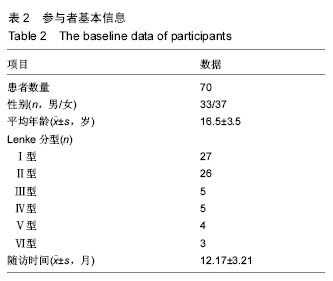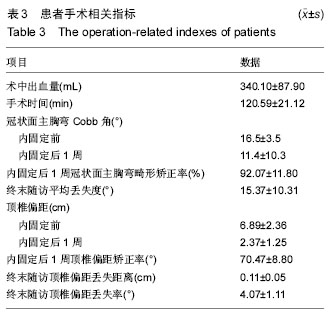| [1] Qiu XS, Wang ZW, Qiu Y, et al. Preoperative pelvic axial rotation: a possible predictor for postoperative coronal decompensation in thoracolumbar/lumbar adolescent idiopathic scoliosis. Eur Spine J. 2013;22(6):1264-1272.
[2] 胡宗杉,邱勇,刘臻,等.单平面椎弓根螺钉联合椎体去旋转技术治疗Lenke 5C型特发性脊柱侧凸[J].中华骨科杂志, 2015,35(11):1151-1158.
[3] 赵志,刘泉.青少年特发性脊柱侧凸的最新研究进展[J].中华全科医学,2013,11(12):1939-1941.
[4] 关永林,何万庆,李盛华,等.全脊柱椎弓根螺钉技术治疗脊柱侧凸疗效观察[J].颈腰痛杂志, 2016, 37(3):238-241.
[5] Vernacchio L, Trudell EK, Hresko MT, et al. A quality improvement program to reduce unnecessary referrals for adolescent scoliosis. Pediatrics. 2013;131(3):e912-920.
[6] Crawford AH, Lykissas MG, Gao X, et al. All-pedicle screw versus hybrid instrumentation in adolescent idiopathic scoliosis surgery: a comparative radiographical study with a minimum 2-Year follow-up. Spine (Phila Pa 1976). 2013;38(14):1199-1208.
[7] Min K, Sdzuy C, Farshad M. Posterior correction of thoracic adolescent idiopathic scoliosis with pedicle screw instrumentation: results of 48 patients with minimal 10-year follow-up. Eur Spine J. 2013;22(2):345-354.
[8] Liang W, Yu B, Wang Y, et al. Comparison of posterior correction results between Marfan syndrome scoliosis and adolescent idiopathic scoliosis-a retrospective case-series study. J Orthop Surg Res. 2015;10:73.
[9] Zaina F, Donzelli S, Lusini M, et al. Adolescent idiopathic scoliosis and eating disorders: is there a relation? Results of a cross-sectional study. Res Dev Disabil. 2013;34(4):1119-1124.
[10] Lonner B, Yoo A, Terran JS, et al. Effect of spinal deformity on adolescent quality of life: comparison of operative scheuermann kyphosis, adolescent idiopathic scoliosis, and normal controls. Spine (Phila Pa 1976). 2013;38(12):1049-1055.
[11] Okada E, Watanabe K, Pang L, et al. Posterior correction and fusion surgery using pedicle-screw constructs for Lenke type 5C adolescent idiopathic scoliosis: a preliminary report. Spine (Phila Pa 1976). 2015;40(1):25-30.
[12] Salmingo RA, Tadano S, Fujisaki K, et al. Relationship of forces acting on implant rods and degree of scoliosis correction. Clin Biomech (Bristol, Avon). 2013;28(2): 122-128.
[13] Grauers A, Danielsson A, Karlsson M, et al. Family history and its association to curve size and treatment in 1,463 patients with idiopathic scoliosis. Eur Spine J. 2013;22(11):2421-2426.
[14] Li M, Fang X, Sun Y, et al. Thoracic curve correction after posterior fusion and instrumentation of structural lumbar curves in patients with adolescent idiopathic scoliosis. Arch Orthop Trauma Surg. 2011;131(10): 1375-1381.
[15] Demura S, Yaszay B, Bastrom TP, et al. Is decompensation preoperatively a risk in Lenke 1C curves? Spine (Phila Pa 1976). 2013;38(11):E649-655.
[16] 于海泉,沈建雄.脊柱侧凸后路矫形融合术后深部感染的治疗[J].中国骨与关节外科,2013,6(z1):39-43.
[17] 钱邦平,毛赛虎,孙旭,等.后路矫形手术对青少年特发性脊柱侧凸患者脊柱高度的影响[J].中国脊柱脊髓杂志,2013, 23(8):694-699.
[18] Hwang SW, Samdani AF, Lonner BS, et al. A multicenter analysis of factors associated with change in height after adolescent idiopathic scoliosis deformity surgery in 447 patients. J Neurosurg Spine. 2013;18(3):298-302.
[19] Hicks JM, Singla A, Shen FH, et al. Complications of pedicle screw fixation in scoliosis surgery: a systematic review. Spine (Phila Pa 1976). 2010;35(11):E465-470.
[20] Coe JD, Arlet V, Donaldson W, et al. Complications in spinal fusion for adolescent idiopathic scoliosis in the new millennium. A report of the Scoliosis Research Society Morbidity and Mortality Committee. Spine (Phila Pa 1976). 2006;31(3):345-349.
[21] 王星,张少杰,史君,等.个体化导航模板辅助儿童腰椎椎弓根螺钉置钉准确性实验研究[J].中华临床医师杂志(电子版),2013,7(23):10784-10787.
[22] 师继红,陆声,张元智,等.数字化脊柱椎弓根导航模板在胸腰椎骨折中的应用[J].中华创伤骨科杂志,2008,10(2): 138-141.
[23] 高方友,王曲,刘窗溪,等.个体化3D打印模型辅助后路螺钉内固定治疗颅颈交界区畸形[J].中华神经外科杂志, 2013,29(9):896-901.
[24] 马立敏,张余,周烨,等.3D打印技术在股骨远端骨肿瘤的应用[J].中国数字医学2013,8(8):70-72.
[25] Wasinpongwanich K, Paholpak P, Tuamsuk P, et al. Morphological study of subaxial cervical pedicles by using three-dimensional computed tomography reconstruction image. Neurol Med Chir (Tokyo). 2014;54(9):736-745.
[26] Lee JY, Lee JW, Pang KM, et al. Biomechanical evaluation of magnesium-based resorbable metallic screw system in a bilateral sagittal split ramus osteotomy model using three-dimensional finite element analysis. J Oral Maxillofac Surg. 2014;72(2):402.e1-13.
[27] Yang M, Zeng C, Guo S, et al. Digitalized design of extraforaminal lumbar interbody fusion: a computer-based simulation and cadaveric study. PLoS One. 2014;9(8):e105646.
[28] Dankowski R, Baszko A, Sutherland M, et al. 3D heart model printing for preparation of percutaneous structural interventions: description of the technology and case report. Kardiol Pol. 2014;72(6):546-551.
[29] 严斌,张国栋,吴章林,等. 3D打印导航模块辅助腰椎椎弓根螺钉精确植入的实验研究[J].中国临床解剖学杂志, 2014,32(3):252-255.
[30] Illés T, Somoskeöy S. Comparison of scoliosis measurements based on three-dimensional vertebra vectors and conventional two-dimensional measurements: advantages in evaluation of prognosis and surgical results. Eur Spine J. 2013;22(6):1255-1263.
[31] Fu J, Liu C, Zhang YG, et al. Three-dimensional computed tomography for assessing lung morphology in adolescent idiopathic scoliosis following posterior spinal fusion surgery. Orthop Surg. 2015;7(1):43-49.
[32] Lenke LG, Betz RR, Harms J, et al. Adolescent idiopathic scoliosis: a new classification to determine extent of spinal arthrodesis. J Bone Joint Surg Am. 2001;83-A(8):1169-1181.
[33] Namikawa T, Matsumura A, Kato M, et al. Radiological assessment of shoulder balance following posterior spinal fusion for thoracic adolescent idiopathic scoliosis. Scoliosis. 2015;10(Suppl 2):S18.
[34] 周恒才,朱锋,邱勇,等.Bending片在预测退变性脊柱侧凸矫形效果中的作用[J].中国矫形外科杂志,2015,23(3): 197-201.
[35] 邢文华,霍洪军,杨学军,等.胸椎椎弓根肋骨复合体应用于脊柱侧弯椎弓根螺钉内固定矫形的影像学评价[J].中国医药科学,2015,4(8):167-169.
[36] Tamai K, Terai H, Toyoda H, et al. Which is the best schedule of autologous blood storage for preoperative adolescent idiopathic scoliosis patients? Scoliosis. 2015;10(Suppl 2):S11.
[37] 周松,朱泽章,邱勇,等.青少年特发性胸椎侧凸顶椎区椎弓根及椎管的形态学特征[J].中国脊柱脊髓杂志, 2013, 23(2):113-118.
[38] 叶斌,孟祥龙,刘玉增,等.徒手置钉技术在脊柱畸形矫正中的准确性与安全性研究[J].脊柱外科杂志,2014,12(1):25-34.
[39] Dede O, Ward WT, Bosch P, et al. Using the freehand pedicle screw placement technique in adolescent idiopathic scoliosis surgery: what is the incidence of neurological symptoms secondary to misplaced screws? Spine (Phila Pa 1976). 2014;39(4):286-290.
[40] Mason A, Paulsen R, Babuska JM, et al. The accuracy of pedicle screw placement using intraoperative image guidance systems. J Neurosurg Spine. 2014;20(2): 196-203.
[41] Marcus HJ, Cundy TP, Nandi D, et al. Robot-assisted and fluoroscopy-guided pedicle screw placement: a systematic review. Eur Spine J. 2014;23(2):291-297.
[42] 张强,赵昌松,袁征,等.导板导航在复杂腰椎椎弓根螺钉置入手术中的初步应用[J].中华临床医师杂志(电子版), 2013, 7(24):11574-11577.
[43] 李明,赵颖川,朱晓东,等.后路全椎弓根螺钉系统治疗青少年特发性脊柱侧凸疗效分析[J].中华外科杂志,2010, 48(6):410-414.
[44] 林必贵,张永刚,张雪松,等.全节段与选择性节段椎弓根螺钉固定治疗重度僵硬型青少年特发性脊柱侧凸比较[J].中华骨科杂志,2010,30(4):330-335. |
.jpg)



.jpg)
.jpg)
.jpg)
.jpg)